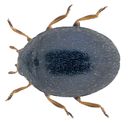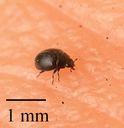Spider Mite Destroyers
Stethorus
Classification
- Phylum: Arthropoda
- Subphylum: Hexapoda
- Class: Insecta
- Order: Coleoptera
- Suborder: Polyphaga
- Superfamily: Coccinelloidea
- Family: Coccinellidae
- Subfamily: Scymninae
- Genus: Stethorus
Pronunciation
How to pronounce Stethorus: //ˈstɛθoʊrəs//
These audio files are automatically generated. While they are not always 100% accurate, they are a good starting point.
Images



Summary
Stethorus is a genus of small beetles known as spider mite destroyers, important in controlling mite populations in various ecosystems, particularly in agricultural settings.
Physical Characteristics
Stethorus beetles are small, typically ranging from 2 to 5 mm in length. They are characterized by their oval shape and shiny black or dark brown coloration, although some species may have distinct markings.
Identification Tips
Look for their small size, shiny appearance, and typically black coloration. They are often found on or near plants infested with spider mites, which they prey upon.
Habitat
Stethorus species inhabit a variety of environments, often found in agricultural fields, gardens, and areas where spider mites are present.
Distribution
Stethorus species are found worldwide, with over 40 described species, including 5 in our area.
Diet
Stethorus beetles primarily feed on spider mites, making them important biological control agents in agricultural settings.
Life Cycle
The life cycle of Stethorus involves four stages: egg, larva, pupa, and adult. Females lay eggs near spider mite colonies, and the larvae feed on the mites before pupating.
Reproduction
Stethorus reproduces via sexual reproduction, and females lay eggs in close proximity to their food sources (spider mites) to ensure larvae have access to food upon hatching.
Ecosystem Role
Stethorus acts as a biological control agent, preying on spider mites and helping to regulate their populations in ecosystems.
Economic Impact
Stethorus beetles are beneficial in agriculture, particularly in controlling spider mite populations and reducing the need for chemical pesticides.
Collecting Methods
- Hand collection from infested plants
- Use of sweep nets in affected areas
Preservation Methods
- Ethanol preservation for genetic studies
- Dry preservation for museum specimens
Evolution
Stethorus is part of the family Coccinellidae, known for their evolution alongside their prey (spider mites), making them specialized predators.
Similar Taxa
- Aphid predators
- Other Coccinellidae species
Misconceptions
While often mistaken for other beetles, Stethorus can be identified by their specific association with spider mites and their shiny, rounded bodies.
Tags
- beetles
- biological control
- agriculture
- pest management